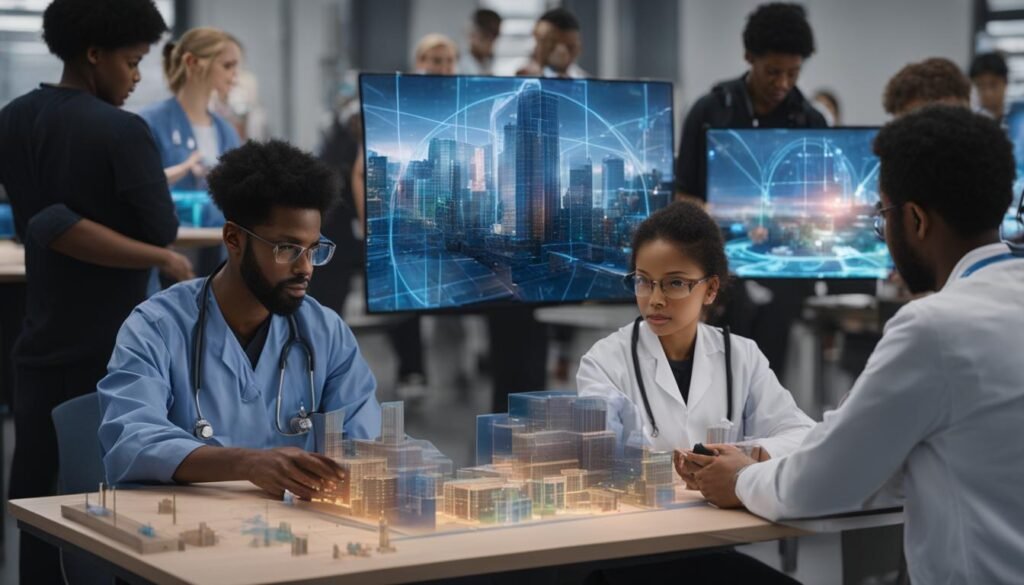Contents
Holography technology has revolutionized the way we perceive and interact with digital content. It enables the creation and display of immersive three-dimensional images, commonly known as holograms. By utilizing the principles of light interference and diffraction, holography has found applications in various fields such as virtual reality, augmented reality, and holographic displays.
Key Takeaways:
- Holography technology creates realistic and immersive three-dimensional images.
- Holography utilizes light interference and diffraction principles.
- Applications of holography include virtual reality, augmented reality, and holographic displays.
- Holography technology continues to evolve with advancements in 360-degree displays and interactive holograms.
- The future of holography holds exciting possibilities for various industries.
Understanding the Principles of Holography
Holography is a fascinating technology that relies on the principles of light interference and diffraction to create and display three-dimensional images. To understand holography better, let’s delve into its fundamental principles and components.
Holographic Structures
Holographic structures are carefully designed to interact with external stimuli and generate holographic images. These structures are composed of a medium that records and reconstructs the interference patterns formed by light. By manipulating the interference patterns, holograms can capture and display intricate details in three dimensions.
Sensitivity Optimization
To optimize holographic structures’ performance, sensitivity optimization techniques are employed. These techniques aim to enhance the structures’ responsiveness when used as sensors or minimize their response when not required. By fine-tuning the sensitivity, holograms can be tailored to specific applications, ensuring optimal performance and efficiency.
Holographic Optical Elements
Holographic optical elements play a crucial role in the functionality of holographic systems, especially in outdoor settings where temperature and humidity variations can impact their performance. These elements are designed to manipulate light beams, redirecting them to create focused holographic images. By carefully engineering holographic optical elements, holograms can be projected with precision and clarity, even in challenging environmental conditions.
By understanding the principles of holography and its key components like holographic structures, sensitivity optimization, and holographic optical elements, we gain insight into the inner workings of this remarkable technology. This knowledge forms a solid foundation for exploring its diverse applications and advancements in various fields.
| Holography Principles | Holographic Structures | Sensitivity Optimization | Holographic Optical Elements |
|---|---|---|---|
| Based on light interference and diffraction | Designed to interact with external stimuli | Optimizes responsiveness and performance | Manipulates light beams for precise projection |
| Creates and displays three-dimensional images | Records and reconstructs interference patterns | Tailored to specific applications | Ensures clarity in challenging environments |
Applications of Holographic Technology
Holographic technology has opened up a world of possibilities across various industries. Its applications span from communication to travel & leisure, healthcare, and education. Let’s explore how holographic technology is transforming these fields.
Holographic Communication
In the realm of communication, holographic technology is revolutionizing the way we interact and connect. It has the potential to enhance video conferencing by providing a more immersive experience. Imagine having a holographic representation of a person right in front of you, making it feel as if they are physically present. This advancement in holographic communication can bridge the gap between physical and virtual interactions, making remote collaborations more engaging and lifelike.
Holographic Travel & Leisure
Holographic technology has found its way into the travel & leisure industry, creating unforgettable experiences for visitors. Museums and entertainment venues are incorporating holographic displays to bring historical figures and performances to life. With holographic projections, visitors can witness lifelike renditions of ancient civilizations or attend concerts featuring legendary artists from the past. This immersive technology adds a whole new dimension to the way we experience culture, entertainment, and leisure activities.
Holography in Healthcare and Education
Holography’s impact extends to the fields of healthcare and education. In healthcare, holographic technology enables 3D visualization of body parts and assists in surgical planning. Surgeons can examine intricate details and practice procedures on holographic representations, enhancing precision and improving patient outcomes. In education, holograms can transform traditional lessons into interactive and engaging experiences. Students can virtually explore historical landmarks, dissect virtual specimens, or even collaborate with holographic teachers, making learning more immersive and memorable.
| Holographic Technology Applications | Industry |
|---|---|
| Holographic Communication | Communication |
| Holographic Travel & Leisure | Travel & Leisure |
| Holography in Healthcare | Healthcare |
| Holographic Education | Education |
As holographic technology continues to advance, we can expect even more applications across diverse industries. The possibilities are endless, and as holography becomes more accessible and integrated into our daily lives, it will shape the future of digital content interaction.
Advancements in Holographic Technology

Holographic technology has been advancing rapidly in recent years, bringing us closer to the futuristic depictions of holograms seen in movies and science fiction. These advancements have opened up new possibilities for immersive visual experiences and interactive applications. Let’s explore some of the latest developments in holographic technology.
Pepper’s Ghost
One classic holographic technique that is still widely used in theaters and concerts is Pepper’s Ghost. This technique uses angled glass or plexiglass to create the illusion of a ghostly image appearing on stage. While Pepper’s Ghost has been around for a long time, it continues to captivate audiences with its mystical and ethereal effects.
Laser Plasma Technology
Another significant advancement in holographic technology is laser plasma technology. This cutting-edge technique allows the creation of 3D holograms in the air, without the need for screens or surfaces. By using lasers to ionize the air, the technology generates plasma that can be manipulated to form realistic and dynamic holographic images. Laser plasma technology paves the way for truly holographic displays that can be experienced from any angle.
360-Degree Holographic Display
A breakthrough in holographic technology is the development of 360-degree holographic displays. These displays provide a fully immersive experience by projecting holograms in a complete circle around the viewer. This advancement brings us closer to the idea of holographic environments, where users can interact with virtual objects from any direction. The 360-degree holographic display technology has applications in gaming, virtual reality, and architectural visualization, among others.
Fairy Light Holograms
One of the most fascinating developments in holographic technology is the creation of Fairy Light holograms. These holograms are not only visually stunning but also interactive. Users can physically touch and feel the holographic projections, making the experience even more engaging. Fairy Light holograms have the potential to revolutionize various industries, including education, entertainment, and advertising.
As holographic technology continues to evolve, we can expect even more exciting advancements in the future. These advancements will redefine the way we perceive and interact with digital content, opening up new possibilities across industries and transforming our visual experiences.
Holography in Various Fields

Holography, with its ability to create realistic and immersive visual experiences, has found applications in various fields, including medicine, orthopaedics, microscopy, neurosurgery, and biology.
Holography in Medicine
In the field of medicine, holographic technology is being explored for clinical imaging and treatment planning. Holography allows healthcare professionals to visualize complex anatomical structures in three dimensions, enabling more accurate diagnoses and improved surgical outcomes. The ability to interact with holographic representations of patient data enhances the understanding of complex medical cases and facilitates effective communication between healthcare providers and patients.
Holography in Orthopaedics
Orthopaedics benefits from holographic technology in surgical procedures and rehabilitation. Holographic simulations can assist orthopaedic surgeons in planning and practicing complex surgeries, improving surgical precision and reducing the risk of complications. Furthermore, holography enables the creation of personalized rehabilitation programs by visualizing and tracking the progress of patients’ movements, promoting more efficient recovery and rehabilitation.
Holographic Microscopy
Holography plays a crucial role in microscopy, allowing high-resolution imaging of biological samples. Through holographic microscopy, researchers can study cellular structures, observe dynamic processes within living cells, and gain insights into the inner workings of biological systems. This technology provides a non-destructive imaging method that preserves the integrity of samples while offering exceptional clarity and detail, advancing our understanding of biology and enabling new discoveries in the field.
Holography in Neurosurgery
Neurosurgery benefits from holography’s ability to create three-dimensional representations of the brain and other neural structures. By visualizing the intricate anatomy of the brain, holographic technology aids neurosurgeons in surgical planning, facilitating precise targeting and reducing the risk of damage to critical areas. Holography also enables real-time visualization during surgeries, assisting surgeons in navigating complex procedures with enhanced precision and safety.
Holography in Biology
In the field of biology research, holography offers a multidimensional perspective to study living organisms and their interactions. Holographic imaging techniques provide valuable insights into cellular dynamics, behavior, and complex biological processes. By visualizing and analyzing holographic data, scientists can unlock new knowledge in areas such as cell biology, ecology, and genetics, paving the way for groundbreaking discoveries and advancements.
| Field | Application |
|---|---|
| Medicine | Clinical imaging and treatment planning |
| Orthopaedics | Surgical procedures and rehabilitation |
| Microscopy | High-resolution imaging of biological samples |
| Neurosurgery | Surgical planning and real-time visualization |
| Biology | Cellular dynamics, behavior, and complex processes |
Conclusion
Holography technology has come a long way and continues to show immense potential for the future. The advancements in holographic technology, including the development of 360-degree displays and interactive holograms, are paving the way for new and exciting possibilities. As holography becomes more accessible and integrated into our everyday lives, we can expect to see further advancements and innovative applications that will reshape the way we perceive and interact with digital content.
Looking ahead, the future of holography technology holds tremendous promise. With ongoing research and development, holographic advancements will likely continue to push the boundaries of what is possible. From holographic communication to healthcare and education, holography is poised to revolutionize various industries and transform the way we experience visual content.
As the technology evolves, we can anticipate holography becoming an integral part of our daily lives, enhancing communication, entertainment, and immersive experiences. The potential for holography to create lifelike and interactive environments is truly exciting, and it will undoubtedly shape the future of digital content in ways we can only imagine.
FAQ
What is holography?
Holography is a groundbreaking technology that allows the creation and display of three-dimensional images, commonly known as holograms. It utilizes the principles of light interference and diffraction to produce realistic and immersive visual experiences.
What are the principles of holography?
Holography operates based on the fundamental principles of light interference and diffraction. Holographic structures are designed to interact with external stimuli and generate holographic images. The sensitivity of holographic structures can be optimized to enhance their performance as sensors or to minimize their response when not required. Holographic optical elements play a crucial role in outdoor settings where temperature and humidity variations can impact their functionality.
What are the applications of holographic technology?
Holographic technology has a wide range of applications across various industries. In communication, holograms can enhance video conferencing and create more immersive interactions. In travel & leisure, holographic technology can be used in museums, live concerts, and other entertainment venues to provide lifelike experiences. In healthcare, holography enables 3D visualization of body parts and assists in surgical planning. In education, holograms can transform traditional lessons into interactive and engaging experiences.
What are the advancements in holographic technology?
Holographic technology has seen significant advancements in recent years. Pepper’s Ghost, a classic holographic technique, is still widely used in theaters and concerts. Laser plasma technology allows the creation of 3D holograms in the air without the need for screens or surfaces. The development of a 360-degree color tabletop holographic display brings us closer to the holographic environments depicted in movies. Another exciting development is Fairy Light holograms, which are interactive and can be physically touched and felt.
In which fields is holography utilized?
Holography has found applications in multiple fields, including medicine, orthopaedics, microscopy, neurosurgery, and biology. In medicine, holography is being explored for clinical imaging and treatment planning. In orthopaedics, holographic technology can assist in surgical procedures and rehabilitation. Holographic microscopy enables high-resolution imaging of biological samples. Additionally, holography is being utilized in neurosurgery and biology research to advance understanding and improve outcomes.



